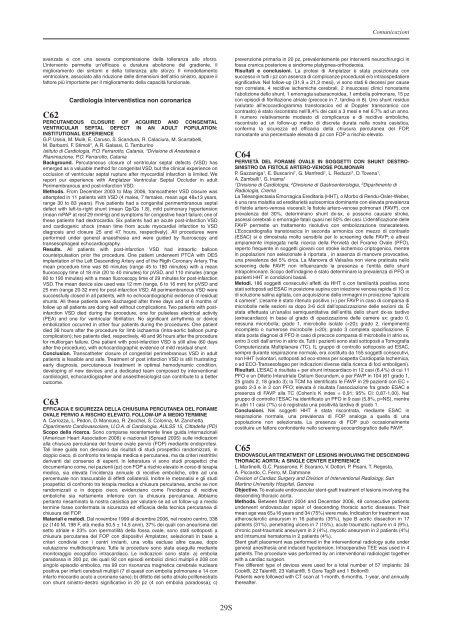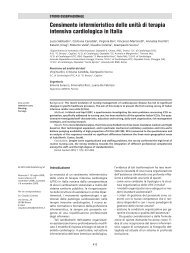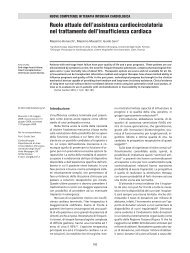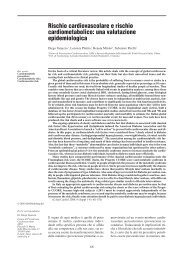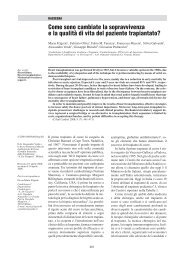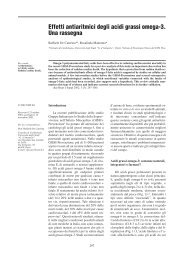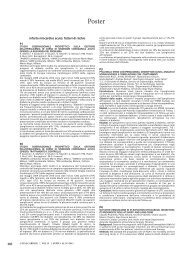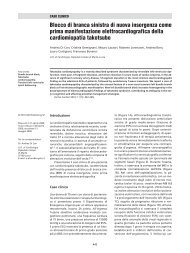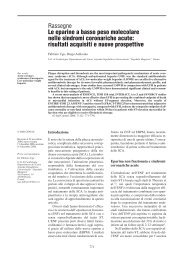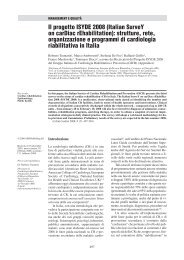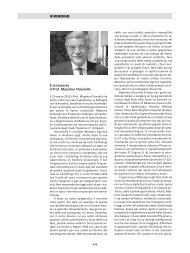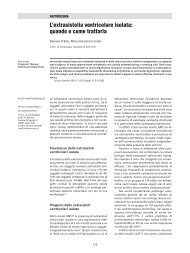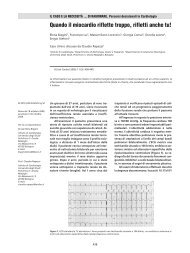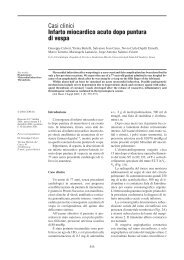COMUNICAZIONI - Giornale Italiano di Cardiologia
COMUNICAZIONI - Giornale Italiano di Cardiologia
COMUNICAZIONI - Giornale Italiano di Cardiologia
You also want an ePaper? Increase the reach of your titles
YUMPU automatically turns print PDFs into web optimized ePapers that Google loves.
Comunicazioni<br />
avanzata e con una severa compromissione della tolleranza allo sforzo.<br />
L’intervento permette un’efficace e duratura abolizione del gra<strong>di</strong>ente, il<br />
miglioramento dei sintomi e della tolleranza allo sforzo. Il rimodellamento<br />
ventricolare, associato alla riduzione delle <strong>di</strong>mensioni dell’atrio sinistro, appare il<br />
fattore più importante per il miglioramento della capacità funzionale.<br />
Car<strong>di</strong>ologia interventistica non coronarica<br />
C62<br />
PERCUTANEOUS CLOSURE OF ACQUIRED AND CONGENITAL<br />
VENTRICULAR SEPTAL DEFECT IN AN ADULT POPULATION:<br />
INSTITUTIONAL EXPERIENCE<br />
G.P. Ussia, M. Mulè, E. Caruso, S. Scandura, R. Calaciura, M. Scartabelli,<br />
M. Barbanti, F. Stimoli*, A.R. Galassi, C. Tamburino<br />
Istituto <strong>di</strong> Car<strong>di</strong>ologia, P.O. Ferrarotto, Catania, *Divisione <strong>di</strong> Anestesia e<br />
Rianimazione, P.O. Ferrarotto, Catania<br />
Background. Percutaneous closure of ventricular septal defects (VSD) has<br />
emerged as a valuable method for congenital VSD, but the clinical experience on<br />
occlusion of ventricular septal rupture after myocar<strong>di</strong>al infarction is limited. We<br />
report our experience with Amplatzer Ventricular Septal Occluder in adult<br />
Perimembranous and post-infarction VSD.<br />
Methods. From December 2003 to May 2006, transcatheter VSD closure was<br />
attempted in 11 patients with VSD (4 males, 7 females, mean age 48±13 years,<br />
range 30 to 83 years). Five patients had a congenital perimembranous septal<br />
defect with left-to-right shunt (mean Qp/Qs 1.8), mild pulmonary hypertension<br />
(mean mPAP at rest 29 mmHg) and symptoms for congestive heart failure; one of<br />
these patients had dextrocar<strong>di</strong>a. Six patients had an acute post-infarction VSD<br />
and car<strong>di</strong>ogenic shock (mean time from acute myocar<strong>di</strong>al infarction to VSD<br />
<strong>di</strong>agnosis and closure 25 and 47 hours, respectively). All procedures were<br />
performed under general anaesthesia and were guided by fluoroscopy and<br />
transesophageal echocar<strong>di</strong>ography.<br />
Results. All patients with post-infarction VSD had intraortic balloon<br />
counterpulsation prior the procedure. One patient underwent PTCA with DES<br />
implantation of the Left Descen<strong>di</strong>ng Artery and of the Rigth Coronary Artery. The<br />
mean procedure time was 80 minutes (range 45 to 180 minutes) with a mean<br />
fluoroscopy time of 18 min (20 to 40 minutes) for pVSD, and 110 minutes (range<br />
80 to 190 minutes) with a mean fluoroscopy time of 29 minutes for post-infarction<br />
VSD. The mean device size used was 12 mm (range, 6 to 16 mm) for pVSD and<br />
25 mm (range 20-32 mm) for post-infarction VSD. All perimembranous VSD were<br />
successfully closed in all patients, with no echocar<strong>di</strong>ographic evidence of residual<br />
shunts. All these patients were <strong>di</strong>scharged after three days and at 6 months of<br />
follow up all patients are doing well without complications. Two patients with postinfarction<br />
VSD <strong>di</strong>ed during the procedure, one for pulseless electrical activity<br />
(PEA) and one for ventricular fibrillation. No significant arrhythmia or device<br />
embolization occurred in other four patients during the procedures. One patient<br />
<strong>di</strong>ed 36 hours after the procedure for limb ischaemia (intra-aortic balloon pump<br />
complication); two patients <strong>di</strong>ed, respectively, 48 and 96 hours after the procedure<br />
for multiorgan failure. One patient with post-infarction VSD is still alive (60 days<br />
after the procedure), with echocar<strong>di</strong>ographic evidence of mild residual shunt.<br />
Conclusion. Transcatheter closure of congenital perimebranous VSD in adult<br />
patients is feasible and safe. Treatment of post infarction VSD is still frustrating:<br />
early <strong>di</strong>agnosis, percutaneous treatment in optimal hemodynamic con<strong>di</strong>tion,<br />
developing of new devices and a de<strong>di</strong>cated team composed by interventional<br />
car<strong>di</strong>ologist, echocar<strong>di</strong>ographer and anaesthesiologist can contribute to a better<br />
outcome.<br />
C63<br />
EFFICACIA E SICUREZZA DELLA CHIUSURA PERCUTANEA DEL FORAME<br />
OVALE PERVIO A RISCHIO ELEVATO. FOLLOW-UP A MEDIO TERMINE<br />
A. Carrozza, L. Pedon, D. Mancuso, R. Zecchel, S. Colonna, M. Zanchetta<br />
Dipartimento Car<strong>di</strong>ovascolare, U.O.A. <strong>di</strong> Car<strong>di</strong>ologia, AULSS 15, Cittadella (PD)<br />
Scopo della ricerca. Sono comparse recentemente linee guida internazionali<br />
(American Heart Association 2006) e nazionali (Spread 2005) sulle in<strong>di</strong>cazioni<br />
alla chiusura percutanea del forame ovale pervio (FOP) me<strong>di</strong>ante endoprotesi.<br />
Tali linee guida non derivano dai risultati <strong>di</strong> stu<strong>di</strong> prospettici randomizzati, in<br />
doppio cieco, <strong>di</strong> confronto tra terapia me<strong>di</strong>ca e percutanea, ma da criteri restrittivi<br />
derivanti dal consenso <strong>di</strong> esperti. In letteratura vi sono stu<strong>di</strong> prospettici che<br />
documentano come, nei pazienti (pz) con FOP a rischio elevato in corso <strong>di</strong> terapia<br />
me<strong>di</strong>ca, sia elevata l’incidenza annuale <strong>di</strong> reci<strong>di</strong>ve emboliche, oltre ad una<br />
percentuale non trascurabile <strong>di</strong> effetti collaterali. Inoltre le metanalisi e gli stu<strong>di</strong><br />
prospettici <strong>di</strong> confronto tra terapia me<strong>di</strong>ca e chiusura percutanea, anche se non<br />
randomizzati e in doppio cieco, evidenziano come l’incidenza <strong>di</strong> reci<strong>di</strong>ve<br />
emboliche sia nettamente inferiore con la chiusura percutanea. Abbiamo<br />
pertanto riesaminato la nostra casistica per valutare se ad un follow-up a me<strong>di</strong>o<br />
termine fosse confermata la sicurezza ed efficacia della tecnica percutanea <strong>di</strong><br />
chiusura del FOP.<br />
Materiali e meto<strong>di</strong>. Dal novembre 1999 al <strong>di</strong>cembre 2006, nel nostro centro, 338<br />
pz (140 M, 198 F, età me<strong>di</strong>a 50,5 ± 14,5 anni), 37% dei quali con aneurisma del<br />
setto atriale e 23% con ipermotilità della fossa ovale, sono stati sottoposti a<br />
chiusura percutanea del FOP con <strong>di</strong>spositivi Amplatzer, selezionati in base a<br />
criteri con<strong>di</strong>visi con i centri invianti, una volta escluse altre cause, dopo<br />
valutazione multi<strong>di</strong>sciplinare. Tutte le procedure sono state eseguite me<strong>di</strong>ante<br />
monitoraggio ecografico intracar<strong>di</strong>aco. Le in<strong>di</strong>cazioni sono state: a) embolia<br />
paradossa in 300 pz, dei quali 92 con episo<strong>di</strong> embolici clinici multipli e 208 con<br />
singolo episo<strong>di</strong>o embolico, ma 99 con risonanza magnetica cerebrale nucleare<br />
positiva per infarti cerebrali multipli (7 <strong>di</strong> questi con embolia polmonare e 14 con<br />
infarto miocar<strong>di</strong>o acuto a coronarie sane); b) <strong>di</strong>fetto del setto atriale polifenestrato<br />
con shunt sinistro-destro significativo in 20 pz (4 con embolia paradossa); c)<br />
prevenzione primaria in 20 pz, prevalentemente per interventi neurochirurgici in<br />
fossa cranica posteriore e sindrome platypnea-orthodeoxia.<br />
Risultati e conclusioni. La protesi <strong>di</strong> Amplatzer è stata posizionata con<br />
successo in tutti i pz con assenza <strong>di</strong> complicanze procedurali e/o intraospedaliere<br />
significative. Nel follow-up (31,9 ± 21,3 mesi), vi sono stati 6 decessi per cause<br />
non correlate, 4 reci<strong>di</strong>ve ischemiche cerebrali, 2 insuccessi clinici nonostante<br />
l’abolizione dello shunt, 1 emorragia subaracnoidea, 1 embolia polmonare, 15 pz<br />
con episo<strong>di</strong> <strong>di</strong> fibrillazione atriale (precoce in 7, tar<strong>di</strong>va in 8). Uno shunt residuo<br />
(valutato all’ecocar<strong>di</strong>ogramma transtoracico ed al Doppler transcranico con<br />
contrasto) è stato riscontrato nell’8,4% dei casi a 3 mesi e nel 6,7% ad un anno.<br />
Il numero relativamente modesto <strong>di</strong> complicanze e <strong>di</strong> reci<strong>di</strong>ve emboliche,<br />
riscontrato ad un follow-up me<strong>di</strong>o <strong>di</strong> <strong>di</strong>screta durata nella nostra casistica,<br />
conferma la sicurezza ed efficacia della chiusura percutanea del FOP,<br />
nonostante una percentuale elevata <strong>di</strong> pz con FOP a rischio elevato.<br />
C64<br />
PERVIETÀ DEL FORAME OVALE IN SOGGETTI CON SHUNT DESTRO-<br />
SINISTRO DA FISTOLE ARTERO-VENOSE POLMONARI<br />
P. Gazzaniga 1 , E. Buscarini 1 , G. Manfre<strong>di</strong> 1 , L. Reduzzi 1 , D. Tovena 1 ,<br />
A. Zambelli 1 , G. Inama 1<br />
1<br />
Divisione <strong>di</strong> Car<strong>di</strong>ologia, 2 Divisione <strong>di</strong> Gastroenterologia, 3 Dipartimento <strong>di</strong><br />
Ra<strong>di</strong>ologia, Crema<br />
La Teleangiectasia Emorragica Ere<strong>di</strong>taria (HHT), o Morbo <strong>di</strong> Rendu-Osler-Weber,<br />
è una rara malattia ad ere<strong>di</strong>tarietà autosomica dominante con elevata prevalenza<br />
<strong>di</strong> fistole artero-venose viscerali; le fistole artero-venose polmonari (FAVP), con<br />
prevalenza del 30%, determinano shunt dx-sx, e possono causare stroke,<br />
ascessi cerebrali o emorragie fatali quasi nel 50% dei casi. L’identificazione delle<br />
FAVP permette un trattamento risolutivo con embolizzazione transcatetere.<br />
L’Ecocar<strong>di</strong>ografia transtoracica in seconda armonica con mezzo <strong>di</strong> contrasto<br />
(ESAC) si è <strong>di</strong>mostrata molto sensibile per lo screening delle FAVP; è altresì<br />
ampiamente impiegata nella ricerca della Pervietà del Forame Ovale (PFO),<br />
reperto frequente in soggetti giovani con stroke ischemico criptogenico, mentre<br />
in popolazioni non selezionate è riportata , in assenza <strong>di</strong> manovre provocative,<br />
una prevalenza del 5% circa. La Manovra <strong>di</strong> Valsalva non viene praticata nello<br />
screening delle FAVP, non influenzando la presenza e l’entità dello shunt<br />
intrapolmonare. Scopo dell’indagine è stato determinare la prevalenza <strong>di</strong> PFO in<br />
pazienti HHT in con<strong>di</strong>zioni basali.<br />
Meto<strong>di</strong>. 186 soggetti consecutivi affetti da HHT o con familiarità positiva sono<br />
stati sottoposti ad ESAC in posizione supina con iniezione venosa rapida <strong>di</strong> 10 cc<br />
<strong>di</strong> soluzione salina agitata, con acquisizione delle immagini in proiezione “apicale<br />
4 camere”. L’esame è stato ritenuto positivo (+) per FAVP in caso <strong>di</strong> comparsa <strong>di</strong><br />
microbolle nelle sezioni sx dopo 3-6 cicli dall’opacizzazione delle sezioni dx. È<br />
stata effettuata un’analisi semiquantitativa dell’entità dello shunt dx-sx tar<strong>di</strong>vo<br />
(extracar<strong>di</strong>aco) in base al grado <strong>di</strong> opacizzazione delle camere sx: grado 0,<br />
nessuna microbolla; grado 1, microbolle isolate (20); grado 3 completa opacificazione. È<br />
stata posta <strong>di</strong>agnosi <strong>di</strong> PFO in caso <strong>di</strong> precoce comparsa <strong>di</strong> microbolle in atrio sx,<br />
entro 3 cicli dall’arrivo in atrio dx. Tutti i pazienti sono stati sottoposti a Tomografia<br />
Computerizzata Multiplanare (TC). IL gruppo <strong>di</strong> controllo sottoposto ad ESAC,<br />
sempre durante respirazione normale, era costituito da 155 soggetti consecutivi,<br />
non HHT (volontari, sottoposti ad eco-stress per sospetta Car<strong>di</strong>opatia Ischemica,<br />
o ad ECO-Transesofageo per in<strong>di</strong>cazioni <strong>di</strong>verse dalla ricerca <strong>di</strong> foci emboligeni).<br />
Risultati. L’ESAC è risultata + per shunt intracar<strong>di</strong>aco in 12 casi (6,4%) <strong>di</strong> cui 11<br />
PFO e un Difetto Interatriale Ostium Secundum, e per FAVP in 104 (61 grado 1,<br />
25 grado 2, 18 grado 3); la TCM ha identificato le FAVP in 29 pazienti con EC +<br />
grado 2-3 e in 2 con PFO; elevata è risultata l’associazione fra grado ESAC e<br />
presenza <strong>di</strong> FAVP alla TC (Cohen’s K index = 0,91; 95% CI: 0,87-1,00). Nel<br />
gruppo <strong>di</strong> controllo l’ESAC ha identificato un PFO in 9 casi (5,8%, p=NS), mentre<br />
in altri 11 casi (7%) si è registrata una positività tar<strong>di</strong>va <strong>di</strong> grado 1.<br />
Conclusioni. Nei soggetti HHT è stata riscontrata, me<strong>di</strong>ante ESAC in<br />
respirazione normale, una prevalenza <strong>di</strong> FOP analoga a quella <strong>di</strong> una<br />
popolazione non selezionata. La presenza <strong>di</strong> FOP può occasionalmente<br />
costituire un fattore confondente nello screening ecocar<strong>di</strong>ografico delle FAVP.<br />
C65<br />
ENDOVASCULAR TREATMENT OF LESIONS INVOLVING THE DESCENDING<br />
THORACIC AORTA: A SINGLE CENTER EXPERIENCE<br />
L. Martinelli, G.C. Passerone, F. Scarano, V. Dottori, P. Pisani, T. Regesta,<br />
A. Piccardo, C. Ferro, M. Dahmane<br />
Division of Car<strong>di</strong>ac Surgery and Division of Interventional Ra<strong>di</strong>ology, San<br />
Martino University Hospital, Genova<br />
Objective. To evaluate endovascular stent-graft treatment of lesions involving the<br />
descen<strong>di</strong>ng thoracic aorta.<br />
Methods. Between March 2004 and December 2006, 48 consecutive patients<br />
underwent endovascular repair of descen<strong>di</strong>ng thoracic aortic <strong>di</strong>seases. Their<br />
mean age was 65±16 years and 34 (75%) were male. In<strong>di</strong>cation for treatment was<br />
atherosclerotic aneurysm in 16 patients (35%), type B aortic <strong>di</strong>ssection in 17<br />
patients (31%), penetrating ulcers in 7 (15%), acute traumatic rupture in 4 (9%),<br />
chronic post-traumatic aneurysm in 2 (4%), mycotic aneurysm in 2 patients (4%)<br />
and intramural hematoma in 2 patients (4%).<br />
Stent graft placement was performed in the interventional ra<strong>di</strong>ology suite under<br />
general anesthesia and induced hypotension. Intraoperative TEE was used in 4<br />
patients. The procedure was performed by an interventional ra<strong>di</strong>ologist together<br />
with a car<strong>di</strong>ac surgeon.<br />
Five <strong>di</strong>fferent type of devices were used for a total number of 57 implants: 39<br />
Cook®, 22 Talent®, 23 Vaillant®, 5 Gore Tag® and 1 Bolton®.<br />
Patients were followed with CT scan at 1-month, 6-months, 1-year, and annually<br />
thereafter.<br />
29S


